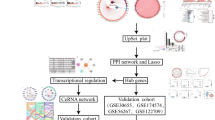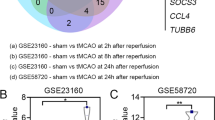Abstract
Ischemic stroke is associated with various physiological and pathological processes including neuronal apoptosis. Growth-arrest-specific transcript 5 (GAS5), a long non-coding RNA (lncRNA), has been recently reported to affect ischemic stroke-induced neuron apoptosis, while its mechanisms remain largely undefined. Through in silico analysis, GAS5 was predicted to interact with the promoter of MAP4K4. The aim of the present study was therefore to investigate the possible role of GAS5 in the progression of ischemic stroke via regulation of mitogen-activated protein kinase kinase kinase kinase 4 (MAP4K4) methylation. The expression of MAP4K4 was found to be lowly expressed in the clinical samples collected from 55 patients. MAP4K4 was suggested to be methylated in an in vitro model of oxygen-glucose deprivation (OGD)-treated mouse primary cortical neurons, while its overexpression could inhibit OGD-induced neuronal apoptosis. A series of dual-luciferase reporter, RIP, RNA pull-down, ChIP MSP, and BSP assays confirmed that GAS5 significantly induced MAP4K4 methylation and downregulated MAP4K4 expression through the recruitment of DNA methyltransferase 3B (DNMT3B). An in vivo ischemic stroke model was developed using middle cerebral artery occlusion (MCAO). Upregulation of GAS5 promoted OGD-induced neuronal apoptosis in the in vitro model and increased cerebral infarction size and neurological score in the in vivo model by reducing MAP4K4 expression. Collectively, the present study highlights that silencing GAS5 may inhibit neuronal apoptosis and improve neurological function in ischemic stroke by suppressing DNMT3B-mediated MAP4K4 methylation, which contributes to better understanding of the pathologies of ischemic stroke and development of novel therapeutic options for this disease.









Similar content being viewed by others
References
Favate AS, Younger DS. Epidemiology of ischemic stroke. Neurol Clin. 2016;34(4):967–80.
Dion F, Saudeau D, Bonnaud I, Friocourt P, Bonneau A, Poret P, et al. Unexpected low prevalence of atrial fibrillation in cryptogenic ischemic stroke: a prospective study. J Interv Card Electrophysiol. 2010;28(2):101–7.
Chimowitz MI. Endovascular treatment for acute ischemic stroke--still unproven. N Engl J Med. 2013;368(10):952–5.
Moskowitz MA, Lo EH, Iadecola C. The science of stroke: mechanisms in search of treatments. Neuron. 2010;67(2):181–98.
Davis SM, Pennypacker KR. Targeting antioxidant enzyme expression as a therapeutic strategy for ischemic stroke. Neurochem Int. 2017;107:23–32.
Zhang X, Hamblin MH, Yin KJ. Noncoding RNAs and stroke. Neuroscientist. 2019;25(1):22–6.
Chen R, Xu X, Huang L, Zhong W, Cui L. The regulatory role of long noncoding RNAs in different brain cell types involved in ischemic stroke. Front Mol Neurosci. 2019;12:61.
Hu X, Liu J, Zhao G, Zheng J, Qin X. Long non-coding RNA GAS5 aggravates hypoxia injury in PC-12 cells via down-regulating miR-124. J Cell Biochem. 2018;119(8):6765–74.
Liu SD, Meng WX, Xu L, Chi C, Sun X, Liu HY. GAS5 promotes myocardial apoptosis in myocardial ischemia-reperfusion injury via upregulating LAS1 expression. Eur Rev Med Pharmacol Sci. 2018;22(23):8447–53.
Tao H, Zhang JG, Qin RH, Dai C, Shi P, Yang JJ, et al. LncRNA GAS5 controls cardiac fibroblast activation and fibrosis by targeting miR-21 via PTEN/MMP-2 signaling pathway. Toxicology. 2017;386:11–8.
Chen F, Zhang L, Wang E, Zhang C, Li X. LncRNA GAS5 regulates ischemic stroke as a competing endogenous RNA for miR-137 to regulate the Notch1 signaling pathway. Biochem Biophys Res Commun. 2018;496(1):184–90.
Zhao RB, Zhu LH, Shu JP, Qiao LX, Xia ZK. GAS5 silencing protects against hypoxia/ischemia-induced neonatal brain injury. Biochem Biophys Res Commun. 2018;497(1):285–91.
Angrand PO, Vennin C, Le Bourhis X, Adriaenssens E. The role of long non-coding RNAs in genome formatting and expression. Front Genet. 2015;6:165.
Liang JJ, Wang H, Rashid A, Tan TH, Hwang RF, Hamilton SR, et al. Expression of MAP4K4 is associated with worse prognosis in patients with stage II pancreatic ductal adenocarcinoma. Clin Cancer Res. 2008;14(21):7043–9.
Gao X, Gao C, Liu G, Hu J. MAP4K4: an emerging therapeutic target in cancer. Cell Biosci. 2016;6:56.
Schroder P, Forster T, Kleine S, Becker C, Richters A, Ziegler S, et al. Neuritogenic militarinone-inspired 4-hydroxypyridones target the stress pathway kinase MAP4K4. Angew Chem Int Ed Engl. 2015;54(42):12398–403.
Al Rahim M, Hossain MA. Genetic deletion of NP1 prevents hypoxic-ischemic neuronal death via reducing AMPA receptor synaptic localization in hippocampal neurons. J Am Heart Assoc. 2013;2(1):e006098.
Li X, Zheng L, Xia Q, Liu L, Mao M, Zhou H, et al. A novel cell-penetrating peptide protects against neuron apoptosis after cerebral ischemia by inhibiting the nuclear translocation of annexin A1. Cell Death Differ. 2019;26(2):260–75.
Khan-Malek R, Wang Y. Statistical analysis of quantitative RT-PCR results. Methods Mol Biol. 1641;2017:281–96.
Nolan T, Hands RE, Bustin SA. Quantification of mRNA using real-time RT-PCR. Nat Protoc. 2006;1(3):1559–82.
Hirano S. Western blot analysis. Methods Mol Biol. 2012;926:87–97.
Hnasko TS, Hnasko RM. The Western blot. Methods Mol Biol. 2015;1318:87–96.
He S, Zhang H, Liu H, Zhu H. LongTarget: a tool to predict lncRNA DNA-binding motifs and binding sites via Hoogsteen base-pairing analysis. Bioinformatics. 2015;31(2):178–86.
Muppirala UK, Honavar VG, Dobbs D. Predicting RNA-protein interactions using only sequence information. BMC Bioinformatics. 2011;12:489.
Bierhoff H. Analysis of lncRNA-protein interactions by RNA-protein pull-down assays and RNA immunoprecipitation (RIP). Methods Mol Biol. 1686;2018:241–50.
Xing Z, Lin C, Yang L. LncRNA pulldown combined with mass spectrometry to identify the novel LncRNA-associated proteins. Methods Mol Biol. 2016;1402:1–9.
Pan J, Li X, Peng Y. Remote ischemic conditioning for acute ischemic stroke: dawn in the darkness. Rev Neurosci. 2016;27(5):501–10.
Li H, Wu Y, Suo G, Shen F, Zhen Y, Chen X, et al. Profiling neuron-autonomous lncRNA changes upon ischemia/reperfusion injury. Biochem Biophys Res Commun. 2018;495(1):104–9.
Ren W, Yang X. Pathophysiology of long non-coding RNAs in ischemic stroke. Front Mol Neurosci. 2018;11:96.
Hernandez-Socorro CR, Rodriguez-Esparragon FJ, Celli J, Lopez-Fernandez JC. Sonographic evaluation of atherosclerosis burden in carotid arteries of ischemic stroke patients and its relation to paraoxonase 1 and 2, MTHFR and AT1R genetic variants. J Neurol Sci. 2017;378:146–51.
Chen L, Yang W, Guo Y, Chen W, Zheng P, Zeng J, et al. Exosomal lncRNA GAS5 regulates the apoptosis of macrophages and vascular endothelial cells in atherosclerosis. PLoS One. 2017;12(9):e0185406.
Zhang XC, Gu AP, Zheng CY, Li YB, Liang HF, Wang HJ, et al. YY1/LncRNA GAS5 complex aggravates cerebral ischemia/reperfusion injury through enhancing neuronal glycolysis. Neuropharmacology. 2019;158:107682.
Yamada Y, Nishida T, Horibe H, Oguri M, Kato K, Sawabe M. Identification of hypo- and hypermethylated genes related to atherosclerosis by a genome-wide analysis of DNA methylation. Int J Mol Med. 2014;33(5):1355–63.
Silva JP, van Booven D. Analysis of diet-induced differential methylation, expression, and interactions of lncRNA and protein-coding genes in mouse liver. Sci Rep. 2018;8(1):11537.
Wei LK, Sutherland H, Au A, Camilleri E, Haupt LM, Gan SH, et al. A potential epigenetic marker mediating serum folate and vitamin B12 levels contributes to the risk of ischemic stroke. Biomed Res Int. 2015;2015:167976.
Hudson WH, Ortlund EA. The structure, function and evolution of proteins that bind DNA and RNA. Nat Rev Mol Cell Biol. 2014;15(11):749–60.
Baubec T, Colombo DF, Wirbelauer C, Schmidt J, Burger L, Krebs AR, et al. Genomic profiling of DNA methyltransferases reveals a role for DNMT3B in genic methylation. Nature. 2015;520(7546):243–7.
Schulze I, Rohde C, Scheller-Wendorff M, Baumer N, Krause A, Herbst F, et al. Increased DNA methylation of Dnmt3b targets impairs leukemogenesis. Blood. 2016;127(12):1575–86.
He X, Chen X, Zhang X, Duan X, Pan T, Hu Q, et al. An Lnc RNA (GAS5)/SnoRNA-derived piRNA induces activation of TRAIL gene by site-specifically recruiting MLL/COMPASS-like complexes. Nucleic Acids Res. 2015;43(7):3712–25.
Liu Y, Zhao J, Zhang W, Gan J, Hu C, Huang G, et al. lncRNA GAS5 enhances G1 cell cycle arrest via binding to YBX1 to regulate p21 expression in stomach cancer. Sci Rep. 2015;5:10159.
Liu T, Wang G, Tao H, Yang Z, Wang Y, Meng Z, et al. Capsaicin mediates caspases activation and induces apoptosis through P38 and JNK MAPK pathways in human renal carcinoma. BMC Cancer. 2016;16(1):790.
Gao J, Liu M, Zou Y, Mao M, Shen T, Zhang C, et al. Long non-coding RNA growth arrest-specific transcript 5 is involved in ovarian cancer cell apoptosis through the mitochondria-mediated apoptosis pathway. Oncol Rep. 2015;34(6):3212–21.
Wang L, Stanley M, Boggs JW, Crawford TD, Bravo BJ, Giannetti AM, et al. Fragment-based identification and optimization of a class of potent pyrrolo[2,1-f][1,2,4]triazine MAP4K4 inhibitors. Bioorg Med Chem Lett. 2014;24(18):4546–52.
Fiedler LR, Chapman K, Xie M, Maifoshie E, Jenkins M, Golforoush PA, et al. MAP4K4 inhibition promotes survival of human stem cell-derived cardiomyocytes and reduces infarct size in vivo. Cell Stem Cell. 2019;24(4):579–91 e512.
Acknowledgments
We would like to acknowledge the reviewers for their helpful comments on this paper.
Funding
This study was supported by the National Key Research and Development Program of China (2016YFC1301501), Beijing Municipal Administration of Hospitals’ Youth Program (QML20180506), National Natural Science Foundation of China (81671776, 81371290 and 81671140), Capital Medical University (PYZ2018080), and the Natural Science Foundation of Beijing (7172070).
Author information
Authors and Affiliations
Contributions
Yiming Deng, Duanduan Chen, Feng Gao, Hong Lv, and Guojun Zhang wrote the paper and conceived and designed the experiments; Xuan Sun, Lian Liu, Dapeng Mo, Ning Ma, and Ligang Song analyzed the data; Xiaochuan Huo, Tianyi Yan, Jingbo Zhang, Yun Luo, and Zhongrong Miao collected and provided the sample for this study. All authors have read and approved the final submitted manuscript.
Corresponding authors
Ethics declarations
The study was approved by the Ethics Committee of Beijing Tiantan Hospital, Capital Medical University. All participating patients signed informed consent documentations and the experiments were conducted in strict accordance with the Declaration of Helsinki. All animal experiments were performed with the approval of the Guide for the Care and Use of Laboratory Animal by International Committees and in strict accordance to Animal Research: Reporting of In Vivo Experiments (ARRIVE) guidelines. The investigators were blind to the data analysis.
Conflict of Interest
The authors declare that they have no conflict of interest.
Additional information
Publisher’s Note
Springer Nature remains neutral with regard to jurisdictional claims in published maps and institutional affiliations.
Electronic Supplementary Material
ESM 1
(PNG 1760 kb)
Rights and permissions
About this article
Cite this article
Deng, Y., Chen, D., Gao, F. et al. Silencing of Long Non-coding RNA GAS5 Suppresses Neuron Cell Apoptosis and Nerve Injury in Ischemic Stroke Through Inhibiting DNMT3B-Dependent MAP4K4 Methylation. Transl. Stroke Res. 11, 950–966 (2020). https://doi.org/10.1007/s12975-019-00770-3
Received:
Revised:
Accepted:
Published:
Issue Date:
DOI: https://doi.org/10.1007/s12975-019-00770-3




